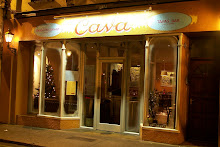Albariño is a variety of white wine grape grown in Galicia (northwest Spain) where it is used to make varietal and blended white wines.
It was presumably brought to Iberia by Cluny monks in the twelfth century. Its name "Alba-Riño" means "the white [wine] from the Rhine" and it has locally been thought to be a Riesling clone originating from the Alsace region of France, although earliest known records of Riesling as a grape variety date from the 15th, rather than the 12th, century. It is also theorized that the grape is a close relative of the French grape Petit Manseng.
Spain produces Albariño to a significant degree in the Rías Baixas DO, especially in the town of Cambados.
In other locations such as Ribeiro, Lima, Braga or Valdeorras it is often mixed with other grapes such as Godello,
to produce blended wines. Such blends were common throughout Galicia too until about 1985; when the Rías Baixas DO was established on an experimental basis in 1986, Albariño began to emerge as a varietal, both locally and international. Its recent emergence as a varietal led the wines to be for wine drinkers who wanted clean flavors and rich, ripe fruit". This has led to wines completely different from those produced across the river in Portugal.
The grape is noted for its distinctive aroma, very similar to that of Viognier and Gewurztraminer, suggesting apricot and peach. The wine produced is unusually light, and generally high in acidity with alcohol levels of 11.5–12.5%.
Its thick skins and large number of pips can cause residual bitterness.
At Cava, we have a number of Albariño's, the most famous of which is the Albariño Castro Martin. It will sent you back about €40. Because of its more complex character, Albariño goes well with food, especially fish and chicken and pork. Why not try with our free range pork next time you're in.
Jp





